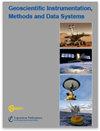多城市大气环境观测活动近时数据管理模块化方法
IF 2.3
4区 地球科学
Q3 GEOSCIENCES, MULTIDISCIPLINARY
Geoscientific Instrumentation Methods and Data Systems
Pub Date : 2024-06-10
DOI:10.5194/egusphere-2024-1469
引用次数: 0
摘要
摘要城市观测网络正变得越来越密集、多样化和流动性更强,同时还需要提供近实时结果。由欧洲研究理事会(ERC)资助的 "城市协同补助金"(Synergy Grant urbisphere)在不同规模的城市同时开展多项实地活动,收集数据,以改进天气和气候模型及服务,包括评估城市对大气(如热量、湿度、污染物和气溶胶排放)和人们对极端天气(如热浪、强降水、空气污染事件)的影响。针对这一挑战,本文提出了一个解决方案,以促进来自多个来源、尺度(如室内、区域尺度大气边界层)和城市的各种数据流。为了在异构城市环境中进行模型开发和评估,我们需要利用地基和机载(遥感)平台建立现场观测的网格网络。在这篇论文中,我们介绍了数据管理、数据基础设施和数据治理方面的挑战、方法和解决方案,以处理主要来自部署在多个城市的新型模块化观测网络的各种数据流,以及合作伙伴收集的现有数据,其规模从室内传感器部署到区域级边界层观测不等。元数据系统记录(1) 传感器/仪器,(2) 部署组件的位置和配置,以及 (3) 维护和事件。根据 FAIR(可查找、可访问、可互操作和可重用)原则,该元数据系统为将仪器记录转换为校准、位置感知、约定一致和质量保证的数据产品提供了基础。数据管理基础设施(通过应用程序接口(API)、应用程序(Apps)、集成电路(ICE)等)为活动参与者提供数据检查和后续计算服务。一些近乎实时的数据会发布到国际网络(如 AERONET、Phenocam)或地方机构(如 GovDATA),并适当注明出处。在这种情况下,用于确保结构化数据集的数据文档惯例,可用于改进城市综合服务的提供,例如向许多城市的研究和业务机构提供服务。本文章由计算机程序翻译,如有差异,请以英文原文为准。
Modular approach to near-time data management for multi-city atmospheric environmental observation campaigns
Abstract. Urban observation networks are becoming denser, more diverse, and more mobile, while being required to provide results in near-time. The Synergy Grant urbisphere funded by the European Research Council (ERC) has multiple simultaneous field campaigns in cities of different sizes collecting data, for improving weather and climate models and services, including assessing the impact of cities on the atmosphere (e.g., heat, moisture, pollutant and aerosol emissions) and people's exposure to extremes (e.g., heat waves, heavy precipitation, air pollution episodes). Here, a solution to this challenge for facilitating diverse data streams, from multiple sources, scales (e.g., indoors, regional-scale atmospheric boundary layer) and cities is presented. For model development and evaluation in heterogeneous urban environments, we need meshed networks of in situ observations with ground-based and airborne (remote-)sensing platforms. In this contribution we describe challenges, approaches and solutions for data management, data infrastructure, and data governance to handle the variety of data streams from primarily novel modular observation networks deployed in multiple cities, in combination with existing data collected by partners, ranging in scale from indoor sensor deployments to regional-scale boundary layer observations. A metadata system documents: (1) sensors/instruments, (2) location and configuration of deployed components, and (3) maintenance and events. This metadata system provides the backbone for converting instrument records to calibrated, location-aware, convention-aligned and quality-assured data products, according to FAIR (Findable, Accessible, Interoperable and Reusable) principles. The data management infrastructure provides services (via, e.g., APIs, Apps, ICEs) for data inspection and subsequent calculations by campaign participants. Some near real-time distributions are made to international networks (e.g., AERONET, Phenocam) or local agencies (e.g., GovDATA) with appropriate attribution. The data documentation conventions, used to ensure structured data sets, in this case are used to improve the delivery of integrated urban services, such as to research and operational agencies, across many cities.
求助全文
通过发布文献求助,成功后即可免费获取论文全文。
去求助
来源期刊

Geoscientific Instrumentation Methods and Data Systems
GEOSCIENCES, MULTIDISCIPLINARYMETEOROLOGY-METEOROLOGY & ATMOSPHERIC SCIENCES
CiteScore
3.70
自引率
0.00%
发文量
23
审稿时长
37 weeks
期刊介绍:
Geoscientific Instrumentation, Methods and Data Systems (GI) is an open-access interdisciplinary electronic journal for swift publication of original articles and short communications in the area of geoscientific instruments. It covers three main areas: (i) atmospheric and geospace sciences, (ii) earth science, and (iii) ocean science. A unique feature of the journal is the emphasis on synergy between science and technology that facilitates advances in GI. These advances include but are not limited to the following:
concepts, design, and description of instrumentation and data systems;
retrieval techniques of scientific products from measurements;
calibration and data quality assessment;
uncertainty in measurements;
newly developed and planned research platforms and community instrumentation capabilities;
major national and international field campaigns and observational research programs;
new observational strategies to address societal needs in areas such as monitoring climate change and preventing natural disasters;
networking of instruments for enhancing high temporal and spatial resolution of observations.
GI has an innovative two-stage publication process involving the scientific discussion forum Geoscientific Instrumentation, Methods and Data Systems Discussions (GID), which has been designed to do the following:
foster scientific discussion;
maximize the effectiveness and transparency of scientific quality assurance;
enable rapid publication;
make scientific publications freely accessible.
 求助内容:
求助内容: 应助结果提醒方式:
应助结果提醒方式:


